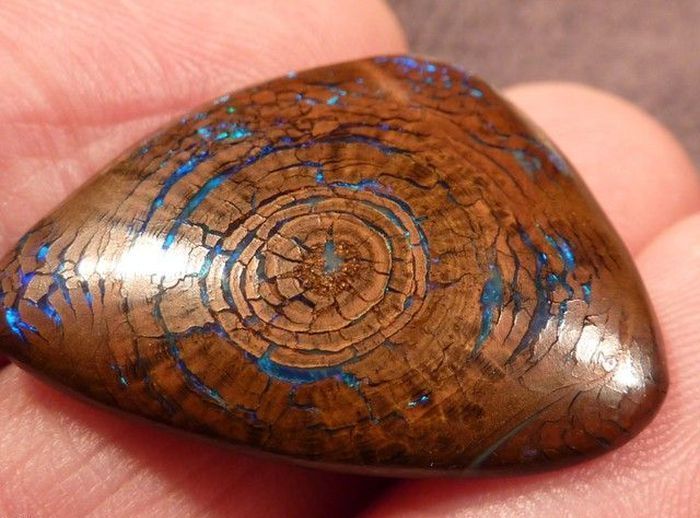|
|
Opalized Wood Boulder Opal
|
Andamooka in South Australia is also a major producer of matrix opal, crystal opal, and black opal. Another Australian town, Lightning Ridge in New South Wales, is the main source of black opal, opal containing a predominantly dark background (dark-gray to blue-black displaying the play of color). Boulder opal consists of concretions and fracture fillings in a dark siliceous ironstone matrix. It is found sporadically in western Queensland, from Kynuna in the north, to Yowah and Koroit in the south. Its largest quantities are found around Jundah and Quilpie (known as the "home of the Boulder Opal") in South West Queensland. Australia also has opalised fossil remains, including dinosaur bones in New South Wales, and marine creatures in South Australia. The rarest type of Australian opal is "pipe" opal, closely related to boulder opal, which forms in sandstone with some iron-oxide content, usually as fossilized tree roots.
The Virgin Valley opal fields of Humboldt County in northern Nevada produce a wide variety of precious black, crystal, white, fire, and lemon opal. The black fire opal is the official gemstone of Nevada. Most of the precious opal is partial wood replacement. The precious opal is hosted and found within a subsurface horizon or zone of bentonite in-place which is considered a "lode" deposit. Opals which have weathered out of the in-place deposits are alluvial and considered placer deposits. Miocene age opalised teeth, bones, fish, and a snake head have been found. Some of the opal has high water content and may desiccate and crack when dried. The largest producing mines of Virgin Valley have been the famous Rainbow Ridge, Royal Peacock, Bonanza, Opal Queen, and WRT Stonetree/Black Beauty Mines. The largest unpolished Black Opal in the Smithsonian Institution, known as the "Roebling Opal," came out of the tunneled portion of the Rainbow Ridge Mine in 1917, and weighs 2,585 carats. The largest polished black opal in the Smithsonian Institution comes from the Royal Peacock opal mine in the Virgin Valley, weighing 160 carats, known as the "Black Peacock."
Another source of white base opal or creamy opal in the United States is Spencer, Idaho. A high percentage of the opal found there occurs in thin layers.
Other significant deposits of precious opal around the world can be found in the Czech Republic, Slovakia, Hungary, Turkey, Indonesia, Brazil (in Pedro II, Piauí), Honduras, Guatemala, Nicaragua and Ethiopia.
|
|









